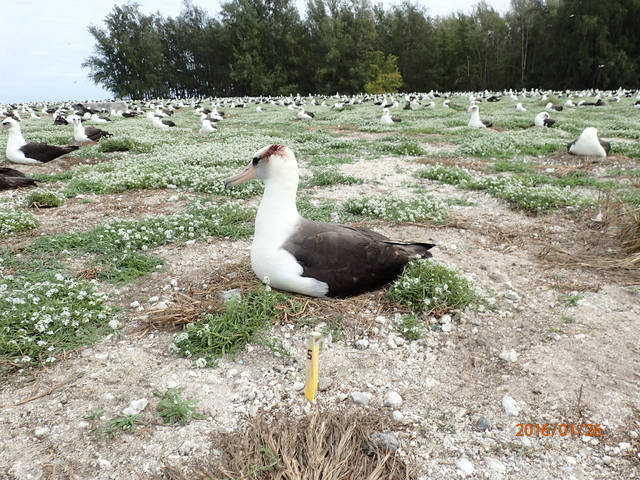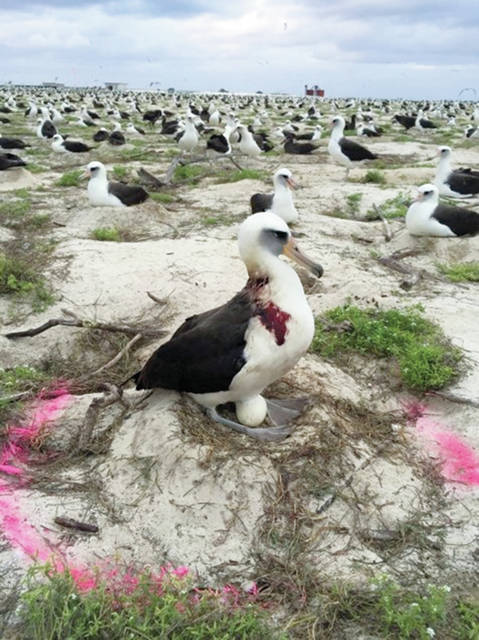LIHUE — While the hunt is still on for remaining rats on Lehua island near Niihau, the U.S. Fish and Wildlife Service is gearing up to target a different island with rodenticide-laced bait designed to destroy house mice.
The place is Midway Atoll’s Sand Island within the Papahanaumokuakea Marine National Monument, where seabirds are being eaten alive by widespread, omnivorous house mice.
“In 2015, volunteers at Midway Atoll made a gruesome discovery,” said Holly Richards, spokeswoman for the USFWS, Pacific Islands. “In the midst of the largest albatross colony in the world, birds were being eaten alive by mice as they sat on their nests.”
Since then, the number of mice attacks has increased from a handful of incidents to hundreds of attacks that have resulted in injury, nest abandonment and death. Laysan albatross are the main targets, and 29 other seabird species are impacted.
According to researchers, in the 2016 and 2017 breeding season the phenomenon resulted in 242 dead albatross, 1,218 bitten birds, and 994 abandoned nests and site locations.
With a conservation status listed as “near threatened,” Laysan albatross range across the north Pacific and are one of 21 species of albatross. They usually pair for life, and a pair will have one egg every one or two years, with both parents working together to hatch and raise the chick.
Wisdom, the oldest known Laysan albatross, hatched a chick on Midway Atoll at the beginning of February with her mate. She’s estimated to be 68 years old, and the duo have not skipped a nesting year since 2006. Over her lifetime she’s raised at least 36 chicks.
“Wisdom is incredibly powerful as a symbol of why we do what we do and why people all over the world pay attention to her,” said Beth Flint, U.S. Fish and Wildlife Service wildlife biologist. “Banded in the 1950s, Wisdom is rewriting history about our understanding of survivorship, how long birds live, and how often they breed.”
The mice on Midway, however, reproduce much faster, and they’ve been present on Midway Atoll for 75 years. Black rats were also present, but were eradicated in 1996. Now, house mice are the only rodent and non-native mammal present in the monument, according to USFWS.
Biologists do not yet know what triggered the mice to begin preying on the albatross. Mice are omnivores — meaning that they will eat any source of food they can find in their quest to survive. And although they had been present on Midway Atoll for decades, there had never been a documented case of predation on adult albatross by mice before the 2015 hatching season, USFWS states.
Albatrosses lack defense mechanisms and are vulnerable to the mice, and researchers say the losses to the colony on Midway from being preyed on by mice will impact the population.
“Because albatross don’t lay eggs every year and, when they do, they raise only one chick at a time, the contribution of even one bird to the population makes a difference,” said Bob Peyton, U.S. Fish and Wildlife Service project leader for Midway Atoll Refuge and Memorial.
So, USFWS and monument co-managers have teamed up with other members of the conservation community to develop a final environmental assessment for aerial dropping of rodenticide-laced bait onto the atoll.
The project follows the same lines as the controversial 2017 eradication for the Lehua Island Ecosystem Restoration Project, in which project partners dropped rat poison from a helicopter onto the island in three different applications that started in August 2017.
Opponents were concerned the rodenticide, diphacinone in that case, would harm the associated fishery and endangered animals like Hawaiian monk seals.
After the summer 2017 poison drops, 45 mullet-like fish were found in Lehua tidepools, and in October 2017 five pilot whales beached themselves on Kauai’s Kalapaki Beach.
Both triggered questions about whether the incidents were linked to the poison project, but samples taken from the fish were too degraded to decipher what killed the animals. Two months after the pilot whales beached themselves, the state Department of Land and Natural Resources said lab tests done on liver samples came back negative for diphacinone.
A year after Lehua was sprinkled with diphacinone, seabird numbers are on the rise but rats still persist on the island. In June, project partners brought in dogs to try and detect the remaining rodents.
That didn’t work as well as it was hoped, and DLNR spokesman Dan Dennison said they need more training.
Now, there are more than 200 devices on the island being used to detect the remaining rats.
A back-up plan discussed in 2017 for Lehua was to repeat the aerial rodenticide application using the more-powerful rat poison brodificoum, which would require the same state Department of Agriculture permits as the 2018 rodenticide drop.
Project partners aren’t confirming whether that’s still an option, but permits haven’t been approved at DOA for the use of that rat poison on Lehua.
But, the plan is to use brodificoum as the rat poison for Sand Island in the summer, the dry season.
According to the final EA: “The toxicant to be applied would be brodifacoum 25ppm, which is a pelleted rodenticide bait intended for conservation purposes for the control or eradication of invasive rodents on islands or vessels.”
“Laysan albatross and other seabirds depend on the habitat protected by Midway Atoll and other Pacific remote wildlife refuges to raise their young,” said Peyton. “Thanks to the hard work of our partners and volunteers, we have been able to restore the native habitat that the birds need for nesting sites, ensuring a future for these seabirds.”
•••
Jessica Else, environment reporter, can be reached at 245-0452 or jelse@thegardenisland.com.






I hope those dang mice try attacking cattle egrets or hawks or eagles!